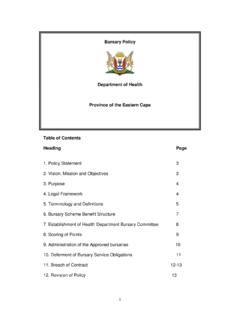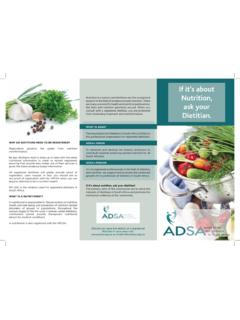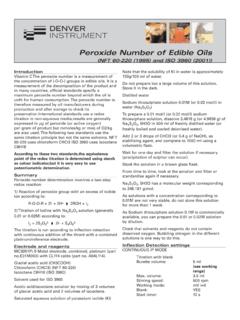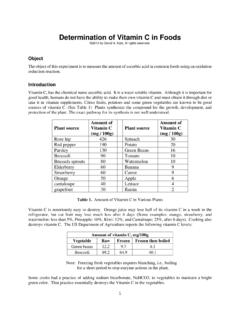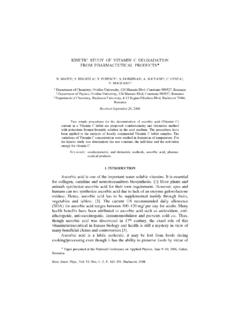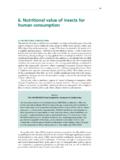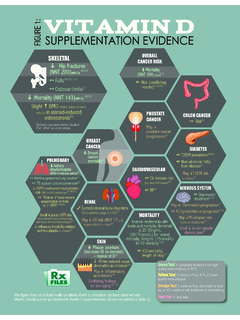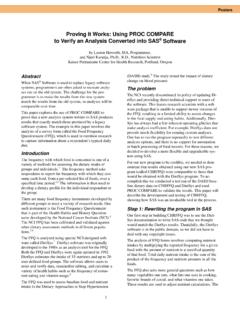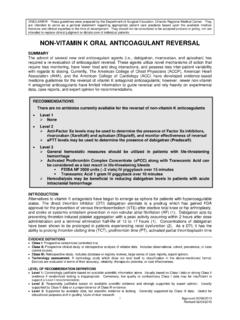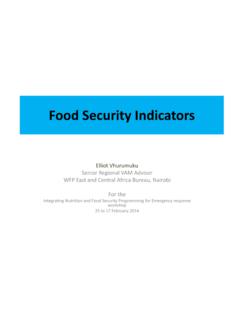Transcription of NATIONAL VITAMIN A SUPPLEMENTATION POLICY ... - ADSA
1 1 NATIONAL VITAMIN A SUPPLEMENTATION POLICY GUIDELINES FOR SOUTH AFRICA 2012 2 PREFACE VITAMIN A deficiency affects 190 million; pre-school children in the World Health Organization (WHO) regions of Africa and South East Asia1. In South Africa in particular, % of children age 1-9 years were found to be VITAMIN A deficient in 2005 NATIONAL Food consumption survey. VITAMIN A deficiency is a major contributor to under-five mortality and can cause visual impairment and increase the risk to illness and death due to measles and diarrhoea. Infants and children have increased VITAMIN A requirements to support rapid growth and to help them fight infections. Improving the VITAMIN A status of deficient children through SUPPLEMENTATION enhances their resistance to disease and can reduce all cause mortality by 23%. South Africa like many other countries has adopted multiple strategic approaches to prevent VITAMIN A deficiency namely food fortification, VITAMIN A SUPPLEMENTATION and dietary diversification.
2 VITAMIN A SUPPLEMENTATION programme in particular was launched in 2001 and was mainly implemented in health facilities through the Expanded Programme for Immunisation (EPI). This approach has shown to be ineffective in reaching children 12-59 months as they are not routinely brought to health facilities for immunisation schedule after the age of 18 months; this is indicated by low coverage of 40%. Other approaches such as child health week days and outreach services have proven to be effective in reaching children 12-59 months and should be adopted by provinces. Over the years WHO; has reviewed research evidence on contribution of VITAMIN A SUPPLEMENTATION in various age groups and concluded that SUPPLEMENTATION for children 0-5 months and postpartum women did not contribute significantly to child and maternal mortality. Instead it is recommended that countries should support and encourage consumption of a diversified diet.
3 The POLICY guidelines are necessary for provision of guidance on how to best address VITAMIN A deficiency in the country. 1 WHO. Guideline: VITAMIN A SUPPLEMENTATION in infants and children 6 59 months of age. 2011. ISBN 978 92 4 150176 7 3 TABLE OF CONTENT Pages PREFACE 2 ACRONYMS 4 1. Introduction 5 Background 5 Situational Analysis of VITAMIN A SUPPLEMENTATION in South Africa 6 Rationale for VITAMIN A SUPPLEMENTATION POLICY guidelines 8 Objectives 8 Target Audience 8 2. Addressing VITAMIN A Deficiency in South Africa 8 Strategy 1: Dietary Diversification 9 Strategy 2: Food Fortification 10 Strategy 3: VITAMIN A Capsule SUPPLEMENTATION 10 Strategy 4: Disease Targeted SUPPLEMENTATION 12 3. VITAMIN A SUPPLEMENTATION Implementation Mechanisms 13 4. VITAMIN A Safety and Handling 15 5.
4 Program Management 16 6. Monitoring and Evaluation 17 Annexure A: Protocols for preventive VITAMIN A SUPPLEMENTATION Annexure B: Protocol on curative VITAMIN A SUPPLEMENTATION schedule 4 ACRONYMS CHW Child Health Week DHIS District Health Information System ECD Early Childhood Development EDL Essential Drug List EPI Expanded Program for Immunisation IMCI Integrated Management of Childhood Illnesses MCC Medicines Control Council MDG Millennium Development Goals NFCS NATIONAL Food Consumption Survey PHC Primary Health Care RtHB Road to Health Booklet SAVACG South African VITAMIN A Consultative Group VAD VITAMIN A Deficiency VAS VITAMIN A SUPPLEMENTATION WHO World Health Organisation 5 1. INTRODUCTION Background The Millennium Development Goals (MDGs) were adopted in 2000 and Goal 4 focuses on improving child survival, with the specific target of reducing the under-five mortality rate by two thirds by 2015.
5 In South Africa the under-five infant and maternal mortality rates are high and increasing. The under-five mortality rate has risen from 59 (1998) to 104 (2007) per 1,000 live births, whereas the 2015 MDG target is 20. The infant mortality rate has remained virtually static at 54 (2001) to 53 (2007) per 1,000 live births, which is equally far from the 2015 MDG target of 182. In South Africa malnutrition is manifested in both under-nutrition and over-nutrition. This paradox of over- and under-nutrition, as well as the range of micronutrient deficiencies of public health significance, requires complementing strategies and an integrated approach to ensure optimal nutrition for all South Africans. Malnutrition leads to increased morbidity and mortality, a poor quality of life and higher healthcare spending. In addition, malnutrition in infants and young children leads to decreased educational achievement and decreased productivity in adulthood.
6 This further entrenches poor quality of life and limits overall economic substantial progress has been made with regard to folate and iodine status, the 2005 NATIONAL Food Consumption Survey (NFCS) indicates other micronutrient deficiencies among women and children still persist and nutritional status may be deteriorating. VITAMIN A Deficiency (VAD) was found in of children and is fairly consistent among the age groups 1-3 years, 4-6 years and 7-9 years4. The Lancet series lists VITAMIN A SUPPLEMENTATION (VAS) among the key interventions achievable at a large scale that have proven to reduce the number of preventable child deaths each year. Thus, VITAMIN A programming is one of the prerequisite for achieving MDG 4, particularly in countries with high under-five mortality and/or VITAMIN A deficiency rates. 2 Department of Health.
7 HRH Strategy for the Health Sector: 2012/13 2016/17. 20 January 2012 3 Department of Health. Child Health Week report. 2009. 4 Department of Health. Roadmap for nutrition in South Africa, 2012-2016. 6 Achieving substantial reductions in child mortality means that all children 6 59 months old living in affected areas need to receive high-dose supplements every 4 6 months5. VITAMIN A deficiency is a major contributor to under-five mortality and can cause visual impairment (night blindness) and can increase the risk of illness and mortality from childhood infections such as measles and those causing diarrhoea. Improving the VITAMIN A status of deficient children through SUPPLEMENTATION enhances their resistance to disease and can reduce mortality from all causes by approximately 23 per cent. Guaranteeing high SUPPLEMENTATION coverage is critical, not only to eliminate VITAMIN A deficiency as a public-health problem, but also as a central element of child survival.
8 Situational Analysis of VITAMIN A SUPPLEMENTATION in South Africa The Department of Health launched a NATIONAL VITAMIN A SUPPLEMENTATION (VAS) program in 2001 following the 1994 SAVACG survey which showed that VITAMIN A deficiency was a public health problem in South Africa. The program started with the creation and adoption of a NATIONAL VITAMIN A SUPPLEMENTATION POLICY targeting children under five and mothers post-partum. VAS was integrated into the Expanded Program for Immunisation (EPI) and Integrated Management of Childhood Illnesses (IMCI) programme in health facilities. This approach has shown to be effective to children 6-12 months as they frequent health facilities for the immunisation schedule. For children 12-59 months VAS coverage has remained low due to the fact that after the age of 18 months these children are not taken to facilities for immunisation, until they are five years.
9 Figure 1 shows the current VAS coverage for children 12-59 months. 5 The United Nations Children s Fund . VITAMIN A SUPPLEMENTATION : A decade of progress. : 978-92-806-4150-9 7 Figure 1: Graph indicating the 2011 VAS Coverage for children 12-59 months To this date, NATIONAL Department of Health has taken steps to improve implementation of best practices for high-impact and cost-effective delivery of child healthcare interventions. In 2008, South Africa launched the first VITAMIN A campaign with the aim of reaching children that are not reached by routine VAS. Subsequently, the NATIONAL integrated Child Health Week (CHW) intervention was then launched in 2009, in eight of its nine provinces. The main purpose of CHW in 2009 was to reach 80% of children aged 12-59 months with essential health services using an outreach strategy.
10 The services provided were VITAMIN A SUPPLEMENTATION (VAS), catch-up immunisation, de-worming and nutritional screening. Through this approach around 80% of children aged 12-59 months were covered as compared to the low coverage from routine SUPPLEMENTATION at health facilities. 8 RATIONALE FOR VAS POLICY GUIDELINES VITAMIN A deficiency is a public health problem in South Africa and it is imperative to have POLICY guidelines that would give guidance on how to address the problem. Over the last couple of years VAS has been reviewed by WHO and all the recommendations that have been adopted in the country are now reflected in the revised protocol. OBJECTIVES Objectives of the VAS POLICY guidelines are: To provide guidance on the revised VAS protocols that have to be implemented in the country To outline the various implementation mechanisms for VAS that can be adopted To describe other strategies to address VAD TARGET AUDIENCE The target audience for the POLICY guidelines will be stakeholders at provinces and districts that implement child survival interventions.

